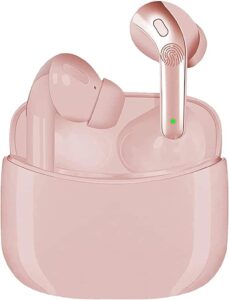In today’s digital age, wireless keyboards have become increasingly popular due to their convenience, flexibility, and freedom from tangled cables. Whether you’re a professional working on a desktop, a gamer seeking enhanced mobility, or a casual user looking for a clutter-free setup, understanding how wireless keyboards work is essential.
This comprehensive guide will delve into the inner workings of wireless keyboards, shedding light on the technology behind them, their components, and the benefits they offer. We’ll also explore the connection process, battery life considerations, maintenance tips, and more.
By gaining a deeper understanding of wireless keyboards, you’ll be equipped to make informed decisions when selecting the right keyboard for your needs and maximize its performance. So, let’s dive in and unravel the fascinating world of wireless keyboards.
Understanding Wireless Keyboards
Wireless keyboards provide the freedom to type and control your computer or device without being tethered by cables. They utilize wireless technology to establish a connection, allowing for a more flexible and convenient user experience. In this section, we will explore the key aspects of wireless keyboards, including the wireless technology used, the components that make them function, and the benefits they offer.
Wireless Technology Explained
Bluetooth and RF (Radio Frequency): Wireless keyboards primarily use Bluetooth or RF technology to establish a connection with the computer or device. Bluetooth is a wireless communication standard found in many devices, while RF uses radio waves to transmit signals.
Communication with the Computer: Wireless keyboards transmit data to the computer or device using the chosen wireless technology. This communication enables the transfer of keystrokes and other commands to the receiving device.
Components of a Wireless Keyboard
Key Switches: Wireless keyboards come with different types of key switches, including membrane and mechanical switches. Membrane switches are more common and feature a rubber membrane under the keys, while mechanical switches provide a tactile feedback and are favored by gamers and enthusiasts.
Battery Compartment and Power Source: Wireless keyboards are powered by batteries, usually AA or AAA. The battery compartment is where the batteries are inserted, providing the necessary power to operate the keyboard wirelessly.
Transmitter and Receiver Modules: Wireless keyboards consist of a transmitter module within the keyboard itself, responsible for sending signals, and a receiver module connected to the computer or device, which receives and interprets the signals.
Benefits of Using a Wireless Keyboard
Cable Clutter Elimination: Wireless keyboards offer a clutter-free workspace by eliminating the need for cables. This enhances desk organization and minimizes tangling issues.
Freedom of Movement: With a wireless keyboard, you can move around more freely, whether you’re giving presentations, controlling media playback, or simply finding a comfortable typing position.
Device Compatibility: Wireless keyboards are compatible with various devices and operating systems, including laptops, desktop computers, tablets, and even smart TVs. They provide the flexibility to switch between devices seamlessly.
Understanding the wireless technology, components, and benefits of wireless keyboards sets the foundation for appreciating their versatility and convenience. In the next section, we will explore the connection process of wireless keyboards, including Bluetooth pairing and RF setup.
The Wireless Keyboard Connection Process
Connecting a wireless keyboard to your computer or device involves a straightforward process that varies depending on the wireless technology used. In this section, we will explore the two primary connection methods: Bluetooth and RF (Radio Frequency).
Bluetooth Connection
Pairing Process: To connect a Bluetooth-enabled wireless keyboard, you need to pair it with your computer or device. Typically, this involves putting the keyboard into pairing mode and initiating the pairing process on the computer or device.
Configuring Bluetooth Settings: Once the pairing process is initiated, your computer or device will search for available Bluetooth devices. Select your wireless keyboard from the list of detected devices and follow any prompts to complete the pairing process. Once paired, your keyboard will be ready to use.
RF Connection
Connecting the Wireless Receiver: RF wireless keyboards come with a USB receiver that needs to be connected to your computer or device. Insert the receiver into an available USB port. In some cases, the receiver may require driver installation, which is typically automated.
Establishing a Secure Connection: Once the receiver is connected, the wireless keyboard and receiver will establish a secure wireless connection. This connection is typically plug-and-play, meaning you can start using the keyboard immediately without any additional configuration.
Troubleshooting Common Connectivity Issues
Pairing or Connection Problems: If you encounter difficulties pairing your Bluetooth keyboard or establishing an RF connection, ensure that the keyboard is in pairing mode and that your computer or device has Bluetooth or the necessary drivers installed. Restarting the devices or updating the keyboard’s firmware and drivers can also help resolve connectivity issues.
Optimizing Wireless Range and Minimizing Interference: If you experience connectivity issues or a limited wireless range, ensure that the keyboard is within the recommended distance from the receiver or device. Keep the keyboard away from potential sources of interference, such as other wireless devices or objects that may block the signal.
By following the appropriate connection process for your wireless keyboard, you can enjoy the freedom and convenience it provides. If you encounter any issues, troubleshooting common connectivity problems can help ensure a seamless and reliable connection. In the next section, we will explore battery life considerations and power management for wireless keyboards.
Battery Life and Power Management of Wireless Keyboard
Wireless keyboards rely on batteries to power their operation. Managing battery life effectively ensures uninterrupted usage and reduces the frequency of battery replacements. In this section, we will discuss the types of batteries used in wireless keyboards, power-saving features, and tips for maximizing battery life.
Types of Batteries Used
AA and AAA Batteries: Wireless keyboards commonly use standard AA or AAA batteries, which are widely available and easy to replace. These batteries provide a balance between power output and convenience.
Rechargeable Batteries: Some wireless keyboards support rechargeable batteries, offering a more sustainable and cost-effective solution in the long run. Rechargeable batteries can be recharged using a charger or through USB charging options provided by certain keyboards.
Power-Saving Features
Sleep Mode: Many wireless keyboards incorporate a sleep mode feature that automatically puts the keyboard into a low-power state when not in use for a certain period. This helps conserve battery life by reducing power consumption during idle times.
Automatic Power-Off: Some keyboards have an automatic power-off feature that turns off the keyboard after a specific period of inactivity. This feature ensures that the keyboard doesn’t drain battery power unnecessarily when not in use.
Tips for Extending Battery Life
Adjust Keyboard Backlighting: If your wireless keyboard has backlighting features, reducing the brightness level or disabling it altogether can significantly extend battery life.
Turn Off the Keyboard When Not in Use: If you anticipate not using the keyboard for an extended period, such as overnight or during travel, turning it off completely can help conserve battery power.
Remove Batteries During Extended Storage: If you plan to store the wireless keyboard for an extended period, removing the batteries can prevent potential battery leakage and preserve their lifespan.
Use Power Management Software: Some wireless keyboards offer power management software or companion applications that allow you to customize power-saving settings. Utilize these features to optimize battery usage according to your preferences.
By adopting power-saving practices and considering rechargeable battery options, you can make the most of your wireless keyboard’s battery life. Regularly monitoring battery levels and being prepared with spare batteries or a charging solution ensures uninterrupted use when needed.
Conclusion
Understanding how wireless keyboards work is essential for harnessing their convenience and flexibility. We’ve explored the wireless technology used, the components of wireless keyboards, and the benefits they offer. Additionally, we discussed the connection process, including Bluetooth pairing and RF setup, and troubleshooting common connectivity issues.
Managing battery life and power consumption is crucial for uninterrupted usage. By utilizing the appropriate types of batteries, taking advantage of power-saving features like sleep mode and automatic power-off, and implementing battery-saving practices, you can extend the lifespan of your wireless keyboard’s batteries and reduce the frequency of replacements.
Furthermore, maintaining and caring for your wireless keyboard ensures its longevity and optimal performance. Regular cleaning, protecting against spills and debris, and adopting good storage practices will help keep your keyboard in excellent condition.
Wireless keyboards have revolutionized the way we interact with our devices, providing freedom of movement and eliminating cable clutter. By following the guidelines outlined in this guide, you can make the most of your wireless keyboard and enjoy a seamless and efficient typing experience.
Now armed with knowledge about wireless keyboards, their connection process, power management, and maintenance, you can confidently select the right wireless keyboard for your needs and enhance your productivity and convenience.
So, go ahead, embrace the wireless revolution, and elevate your computing experience with the versatility and freedom offered by wireless keyboards.



